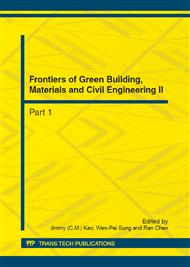p.1033
p.1038
p.1048
p.1052
p.1056
p.1061
p.1065
p.1069
p.1075
Time Dependent Rotational Displacement of Retaining Wall under Seismic Condition
Abstract:
A simple pseudo-dynamic method to predict the seismic rotational displacement of retaining wall is developed. The proposed method, which soil-structure interaction is considered, is a combination of the free-field seismic response of soil and pseudo-dynamic method. It is supposed that soil and structure is connected by a series of springs, the dynamic earth pressure is determined by the deformation of springs. So both active and passive conditions can be taken into account by means of different movement direction of retaining wall, no need to know whether active or passive earth pressure happens before analysis. A significant difference between this analysis and published method is that in the present analysis the time dependent process of earth pressure and displacement is obtained by iterative calculation. Although present analysis is limit to elastic state, comparisons with Mononobe-Okabe method show satisfactory agreement in the value of resultant forces acting on retaining wall. Moreover, it is revealed by numerical examples that the height of the resultant force from the base of the wall is underestimated by the Mononobe- Okabe method, this may cause unsafe factors. Furthermore, the effect of wide range of parameters like time, height of retaining wall, wall friction, horizontal and vertical seismic coefficients are taken into account to evaluate the seismic response of retaining wall. Apart from its intrinsic theoretical interest, the proposed analysis can be used for the assessment of the safety of retaining wall under seismic condition.
Info:
Periodical:
Pages:
1056-1060
Citation:
Online since:
August 2012
Authors:
Price:
Сopyright:
© 2012 Trans Tech Publications Ltd. All Rights Reserved
Share:
Citation:


